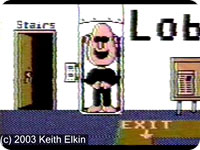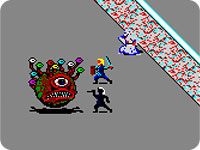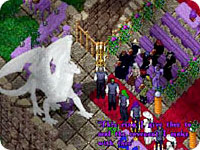The Acronym Stew That Led to Modern MMORPGs
(MMORPGs: Massively Multiplayer Online Role-Playing Games)
Dungeons & Dragons, of course, introduced the world to the concept of creating a character and role-playing through a variety of fantasy quests. Eventually the RPG concept expanded into all manner of genres, although those who played those pencil-and-paper games could only include players who lived in the immediate vicinity. We’re sure someone, somewhere attempted at least one massively multiplayer session of D&D with dozens of people — and probably found it chaotic and unfocused.
Around the time D&D and its ilk hit their stride, however, people with access to mainframe computers began developing multi-user domains (or dungeons), commonly known as MUDs. Since this was happening in the late 1970s, the games were text-based and simple, with command-line interfaces similar to the ones that would later show up on such home computer games as Zork.
For example, you might type “enter room,” and the program would tell you who was in the room, along with a description of it. Sometimes the goal was to simply socialize and chat with other players, while others created hack-and-slash MUDs in which everyone gathered to slay monsters and collect loot. You could play as yourself or take on a role of your own invention.
Off-shoots of MUDs include MOOs (MUD Object-Oriented) and MUSHes (Multi-User Shared Hack/Habitat/Holodeck/Hallucination).
MMORPGs Come of Age
The first widely available text-based MMORPG was Islands of Kesmai, which debuted in 1984 on CompuServe. One of the earliest graphical MMORPGs was Habitat, a title released by LucasFilm in 1986 for the Commodore 64 computer. Gamers could play it on Quantum Link, a service that eventually became America Online. It ended its pilot run in 1988 and turned into Club Caribe.
Neverwinter Nights was the first mainstream graphical MMORPG with a fantasy setting. It debuted on America Online in 1991 and lasted until 1997. The game grew out of the Dungeons & Dragons “Gold Box” computer games that had launched in 1988 and were very popular. BioWare licensed it for the Neverwinter Nights role-playing games that are available for the Mac today.
Other MMORPGs soon followed, including Meridian 59, which was the first to use 3D graphics, and Ultima Online, which was based on a popular series of computer games and proved to be the genre’s best-selling effort so far. In 1999, however, Sony released EverQuest, which set the standard for MMORPGs that have followed since then, especially the fantasy-themed ones. It was so popular that such mainstream news publications as Time magazine covered the phenomenon.
Today, as you can see by the wide diversity of MMORPGs currently available, the genre shows strength through diversity. No matter where your interests lie, you can find online worlds full of players who share them.



